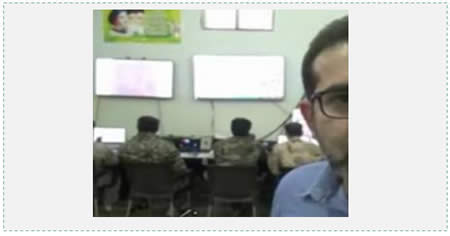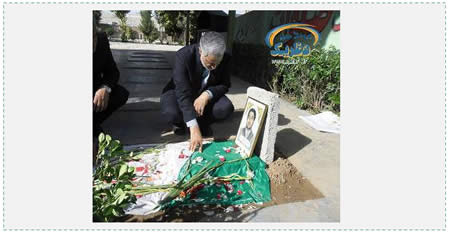Overview1
|
Statements from Senior Iranian Officials about Iran's Regional Involvement
- Ebadollah Abdollahi, commander of the IRGC's construction headquarters Khatam al-Anbiya, told a press conference that the headquarters had informed senior Iranian officials it was prepared to begin operations in Syria, if conditions permitted. He said the headquarters was already active in water purification and the construction of a gas pipeline in Iraq, and was preparing to build a railway that would connect southern Iran with Karbala in Iraq, facilitating the movement of Iranian pilgrims to the Iraqi sites sacred to Shi'a (Tasnim News, December 14, 2015).
Iranian Intervention in Syria
- At least 20 IRGC fighters were killed in Syria during the past two weeks, two of them with the rank of colonel. One of them, Colonel Sattar Mahmoudi, commanded aerial defense at the naval base at Bushehr. He was apparently killed in the region of Latakia.
- Also killed was Hossein Fadaei, a senior commander in the Fatemiyoun Brigade, composed of Afghans fighting under IRGC command.
- Iran denied last week's Western media reports that it had begun withdrawing its military forces from Syria in the wake of heavy losses suffered in the ground offensive that began at the beginning of October 2015. Hossein Amir Abdollahian, deputy foreign minister for Arab-African affairs, said that Iran's "military advisors" continued supporting the Syrian regime in its war on terrorism (Fars News, December 14, 2015). Hojjat-ul-Islam Abdollah Haji Sadeghi, the IRGC's deputy representative of the Iranian supreme leader, also denied reports Iran was decreasing the number of IRGC forces in Syria, claiming Iran and the IRGC would continue "advising" the Syrian regime (Tasnim News, December 15, 2015).
- The Iranian media claimed the reports that the IRGC was withdrawing its forces from Syria were "lies" and part of the West's psychological warfare against Iran which also included reports that Qasem Soleimani, commander of the IRGC's Qods Force, had been wounded in Syria.
- In all probability, even if Iran does withdraw some of its forces from Syria, it will involve no more than a few hundred fighters. It may also be a tactical withdrawal, part of the routine replacement of fighting forces. In any event, there is no proof that the IRGC's heavy losses in Syria have made Tehran rethink its military involvement in Syria or its commitment to Bashar Assad's regime.
- Mohammad-Ali Jafari, commander of the IRGC, appointed Qolam-Hossein Qeibparvar to command the Imam Hossein Headquarters. Qeibparvar replaces Hossein Hamedani, who was killed in Syria in October. Qeibparvar formerly commanded the IRGC's Fajr Unit (Fars News, December 9j, 2015). The Imam Hossein Headquarters are responsible for the operations of the Imam Hossein Battalions, the elite fighting units of the IRGC's Basij force, which play a major role in the fighting in Syria. According to a number of reports, the headquarters are responsible for coordinating Iranian fighting in Syria.
- Mohammad-Ali Jafari, commander of the IRGC, said of the continuing fighting in Syria that the fate of the world and the future of Islam would be decided in the confrontations and wars in Western Asia. Speaking at a meeting of the families of IRGC fighters from Khuzestan Province killed in Syria, he said that today IRGC fighters were defending their country from a distance of several thousand kilometers from its borders. He added that the United States no longer had the capability to directly confront the Muslim countries (Tasnim News, December 9, 2015).
- Iranian news websites reported that Syrian President Bashar Assad was expected to arrive in Tehran for a visit on January 10, 2016. According to the reports, he would meet with senior Iranians to discuss the international talks on Syria's future and the plan to hold elections in Syria (Alef, December 14, 2015).
- Ali-Akbar Velayati, senior advisor to the supreme leader for international affairs, after meeting with Ali Hassan Khalil, Lebanese minister of finance, told a press conference that Iran, Lebanon and Syria were united in defending the Syrian people and Bashar Assad. He said he hoped that in the near future the Syrian government would reestablish its legal rule over the country and preserve its territorial integrity (Mehr News Agency, December 8, 2015).
- Iran criticized the conference held by the Syrian opposition in Riyadh, Saudi Arabia. Hossein Amir Abdollahian, deputy foreign minister for Arab-African affairs, condemned the conference, saying it violated the declaration made at the international talks held in Vienna about Syria's future. Worse, he said, was that several terrorist groups affiliated ISIS had participated. He said the world would not allow "terrorists" to represent themselves as moderate opposition and decide the future of Syria and the region (Fars News, December 10, 2015). On another occasion, Abdollahian denied Russia and Iran were at odds regarding Syria. Interviewed by the IRNA news agency, he said the two countries were supporting the Syrian army in its struggle against terrorism (IRNA, December 13, 2015).
Iranian Intervention in Iraq
- Hassan Danaeifar, Iranian ambassador to Iraq, said the joint Iranian-Syrian-Iraqi-Russian committee established to share intelligence would, in the near future, become a coalition of the four countries. He also referred to Iran's position on reform plan proposed by Iraqi President Hayder el-Abadi, saying that Iran supported reforms in Iraq and was ready to give the Iraqi government the benefit of its experience. In addition, he said that Iran opposed any plan which would divide Iraq (Mehr News Agency, December 13, 2015).
Iranian Intervention in the Palestinian Arena
- Ismail Haniya, deputy head of Hamas' political bureau, sent a video-taped message asking Iran to support Hamas against Israel. The video was posted to Iranian news websites. Haniya asked the leaders and citizens of Iran to help the Palestinians wage the "third intifada." He said he was aware of the special status Jerusalem and Palestine had for the people and leaders of Iran. He therefore called on them, and on all Arabs and Muslims, to send strategic support for the intifada so the Palestinian could continue it and achieve their goals of defending Jerusalem and Al-Aqsa mosque and liberating Palestine (Raja News, December 9, 2015).
- The video was made as the political crisis between Iran and Hamas continues unabated, the result of Hamas' siding with the Sunni camp led by Saudi Arabia over the Syrian civil war and the Saudi attacks in Yemen.
- As to relations between Iran and Hamas, senior Hamas figure Ahmad Yousef told the London-based Al-Quds Al-Arabi that since the outbreak of the Syrian civil war Iran's support for Hamas had been limited to military matters. Yousef, who was quoted by the Iranian media, said Iran continued its military support for the Izz al-Din al-Qassam Brigades [Hamas' military-terrorist wing], but the differences of opinion between Iran and Hamas regarding Syria prevented the normalization of relations (Entekhab, December 15, 2015).
- Mohammad Javad Zarif, the Iranian foreign minister, said that Iran's position on the Palestinian issue had not changed. Meeting with Khalid al-Qoddoumi, Hamas' representative in Iran, Zarif said that Iran's position on the Palestinian issue had not changed since the Islamic Revolution and that it was an ideological position, not a political one. Al-Qoddoumi updated Zarif on the situation in the West Bank, the Gaza Strip and Jerusalem, and stressed the need to expand relations between Hamas and Iran. The Fars news agency reported that al-Qoddoumi and Zarif had agreed on a joint framework for continuing Iranian support for the Palestinians (Fars News, December 7, 2015).
Iranian Intervention in Yemen
- Iran repeated its calls for an end to "Saudi aggression" in Yemen. Hossein Amir Abdollahian, deputy foreign minister for Arab-African affairs, held a telephone conversation with Ismail Ould Cheikh Ahmed, the UN secretary general's representative for Yemeni affairs. Abdollahian called for an end to the Saudi aerial attacks in Yemen and stressed Iran's support for the reconciliation talks between the various Yemeni factions (Fars News, December 10, 2015).
Iran's Responses to the Military Attack on the Shi'ites in Northern Nigeria
- Iran strongly condemned the bloody attack carried out by the Nigerian army against a group of Shi'ites in the city of Zaria in northern Nigeria, during which several hundred people were killed and wounded. Among those killed was Sheikh Mahmoud Mohammad Touri, deputy of the leader of the Islamic Movement in Nigeria, Sheikh Ibraheem Zakzaky. Sheikh Zakzaky was arrested by the Nigerian army and wounded during the raid on his house.
- Hossein Jaber Ansari, spokesman for the Iranian foreign ministry, criticized the attack and called on the Nigerian authorities to respect the country's various religious groups. Mohammad Javad Zarif, the Iranian Foreign Minister, also called on the Nigerian government to take immediate steps to end the violence and protect the lives of Nigeria's Muslims. Speaking on the phone to the Nigerian Foreign Minister, Zarif said Iran was worried by the "tragic slaughter of Shi'ite Muslims" in Zaria (Mehr News Agency, December 14, 2015).
- Hossein Amir Abdollahian, deputy Foreign Minister, said of the incident in Zaria that the fate of Sheikh Zakzaky was extremely important to Iran and the Muslim world and required clarification and assurances of his health and wellbeing. He said the Iran had very good relations with Nigeria and was using the good atmosphere between them to inform Nigeria that Iran held it was responsible for the attack in the northern part of the country (Fars News, December 14, 2015). On December 14, 2015, the Nigerian attaché was summoned to the Iranian foreign ministry to clarify the situation. Senior Iranian clerics also strongly criticized the attack and called on the Nigerian authorities to release Sheikh Zakzaky immediately. On December 15, 2015, Iranian civilians held a protest demonstration in front of the Nigerian embassy in Tehran (IRNA, December 15, 2015).
- For years Iran has had ties to Zakzaky's Shi'ite Islamic Movement in Nigeria. This past August Zakzaky participated in a conference held in Mashhad in Iran, during which he expressed support for Iran, calling it a role model and symbol of the struggle against tyranny and the West.
- On October a, 2015 Daoud Amran, secretary general of the Islamic Association of Nigeria, told the London-based newspaper Al-Sharq Al-Awsat that Iran was training 3,000 Nigerian Shi'ites for fighting in Syria. He said the training was overseen by the Iranian embassy in Abuja and the Iranian consulate in Lagos, part of the Islamic Republic's increasing efforts to deepen its influence among the Shi'ites in Nigeria. He warned of an increase in Iranian activity in Nigeria, and claimed Iran was transferring money through Nigerian charitable funds with the support of Sheikh Ibraheem Zakzaky.
[1]Spotlight on Iran is an Intelligence and Terrorism Information Center bulletin illuminating Iran's activities to establish its influence in the Middle East and beyond. It is based on reports in the Iranian media and written for the ITIC by Dr. Raz Zimmt, an expert on Iran's politics, society, foreign policy and social networks.
















































